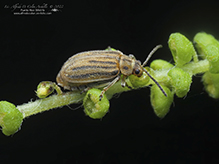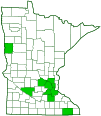ragweed leaf beetle
(Ophraella communa)
Conservation • Description • Habitat • Ecology • Distribution • Taxonomy
Conservation Status |
|
|||||||
| IUCN Red List | not listed |
|||||||
| NatureServe | NNR - Unranked |
|||||||
| Minnesota | not listed |
|||||||
Description |
||
Ophraella communa is a small, native, skeletonizing leaf beetle. It is one of two beetles that are known by the common name ragweed leaf beetle. It is native to Canada, the United States, and Mexico, and it has been introduced into western Asia and southern Europe. In the U.S., it occurs mostly east of the Great Plains, but there are scattered reports throughout the rest of the country. Adults and larvae are food specialists. In the eastern U.S., they feed exclusively on common ragweed. In the west, they have been reported feeding on common ragweed, western ragweed, rough cocklebur, gray-headed coneflower, poverty weed, and Texas blueweed. All of these plants are in the tribe Heliantheae of the family Asteraceae. The larvae feed in spring. They chew holes in the leaves between the veins, leaving a lace-like (skeletonized) pattern. Adults of the new generation are active from May through September. They chew circular to elliptical holes in the leaves. Adults are ⅛″ to ¼″ (4.2 to 5.3 mm) long and 1⁄16″to ⅛″ (1.8 to 2.8 mm) wide. The body is oblong oval when viewed from above, convex but somewhat depressed when viewed from the side. It is mostly yellowish brown (pale) with dark brown to black (dark) markings. The head is inserted shallowly into the first segment of the thorax and is clearly visible from above. It is pale with a dark spot on the top (vertex). The spot varies from a narrow longitudinal line to a large patch expanding to the sides on the rear margin. The antennae have 11 segments and are less than half as long as the body. They vary from mostly dark throughout to mostly pale at the base and grading to mostly dark at the tip. The third antennal segment is longer than the fourth. The antennae bases are close together. The eyes are not notched. The mouthparts are directed downwards. The plate covering the first segment of the thorax (pronotum) is two times wider than long, it is distinctly depressed on each side, and it has distinct flattened lateral margins. There is a dark longitudinal stripe in the middle and a dark spot on each side. The hardened wing covers (elytra) are rounded in the shoulder (humeral) area, nearly parallel along the sides, and broadly rounded at the tip. They are densely covered with erect and recumbent hairs, and they are finely and closely pitted (punctate). Each elytron has four distinct, dark, longitudinal stripes. The stripe on the inner margin (sutural stripe) begins about one-third way from the base. The second stripe (1st discal stripe) begins at the base and extends inward at an angle, merging with the sutural stripe about halfway from the base. The third stripe (2nd discal stripe) is on only the rear half of the elytron. The fourth stripe (lateral stripe) extends from the base in the humeral area to near the tip. The legs are pale. |
||
Size |
||
Total length: ⅛″ to ¼″ (4.2 to 5.3 mm) |
||
Similar Species |
||
Habitat |
||
|
||
Ecology |
||
Season |
||
One generation per year: May through September |
||
Behavior |
||
|
||
Life Cycle |
||
A cluster of eggs is laid on the underside of a young leaf of a host plant. When the eggs hatch, the larvae feed, fully exposed, on the leaves of the host plant. When mature, each larva spins a cocoon, attaches it to a leaf tip, and pupates. Adults emerge in one to two weeks. In the fall, adults drop to the ground and overwinter in leaf litter. |
||
Larva Food |
||
Roots of common ragweed |
||
Adult Food |
||
Leaves of common ragweed |
||
Distribution |
||||
|
Sources |
|||
| 1/21/2024 | ||||
Occurrence |
||||
Locally abundant |
||||
Taxonomy |
|||
Order |
Coleoptera (Beetles) | ||
Suborder |
Polyphaga (Water, Rove, Scarab, Long-horned, Leaf, and Snout Beetles) | ||
Infraorder |
Cucujiformia | ||
Superfamily |
Chrysomeloidea (leaf beetles and allies) | ||
Family |
Chrysomelidae (leaf beetles) | ||
Subfamily |
Galerucinae (skeletonizing leaf and flea beetles) | ||
Tribe |
Galerucini | ||
| Section | Schematizites | ||
Genus |
Ophraella | ||
A recent revision of the genus Ophraella (LeSage, 1986) applied the name Ophraella notulata to the species formerly designated as Ophraella integra. The species until then designated as Ophraella notulata became Ophraella communa. |
|||
Synonyms |
|||
|
|||
Common Names |
|||
ragweed flea beetle ragweed leaf beetle |
|||
Glossary
Elytra
The hardened or leathery forewings of beetles used to protect the fragile hindwings, which are used for flying. Singular: elytron.
Pronotum
The exoskeletal plate on the upper side of the first segment of the thorax of an insect.
Punctate
Dotted with pits (punctures), translucent sunken glands, or colored spots of pigment.
Vertex
The upper surface of an insect’s head.
Visitor Photos |
|||||
Share your photo of this insect. |
|||||
| This button not working for you? Simply email us at info@MinnesotaSeasons.com. Attach one or more photos and, if you like, a caption. |
|||||
Alfredo Colon |
|||||
 |
|||||
MinnesotaSeasons.com Photos |
|||||
|
|||||

Slideshows |
||

Visitor Videos |
|||
Share your video of this insect. |
|||
| This button not working for you? Simply email us at info@MinnesotaSeasons.com. Attach a video, a YouTube link, or a cloud storage link. |
|||
Other Videos |
|||
| The Ambrosia leaf beetle Ophraella communa Observatoire des espèces enjeux santé humaine |
|||
About
Jul 25, 2018 “Do you know this insect? |
|||

Created: 1/21/2024
Last Updated:


